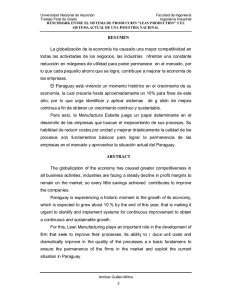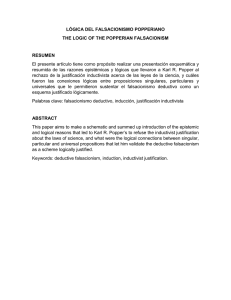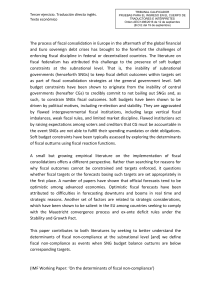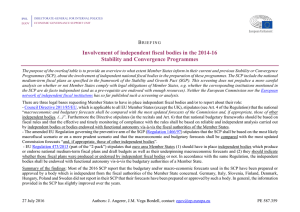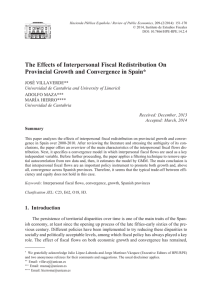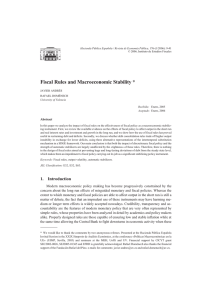El último capítulo de este breve estudio analiza la
Anuncio
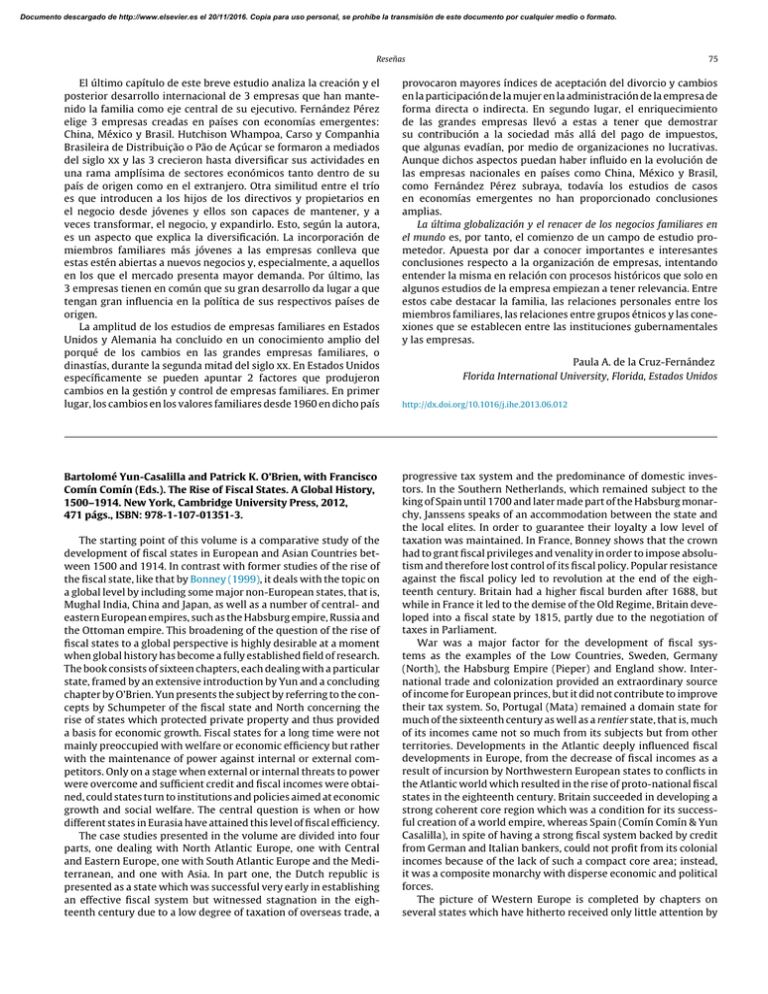
Documento descargado de http://www.elsevier.es el 20/11/2016. Copia para uso personal, se prohíbe la transmisión de este documento por cualquier medio o formato. Reseñas El último capítulo de este breve estudio analiza la creación y el posterior desarrollo internacional de 3 empresas que han mantenido la familia como eje central de su ejecutivo. Fernández Pérez elige 3 empresas creadas en países con economías emergentes: China, México y Brasil. Hutchison Whampoa, Carso y Companhia Brasileira de Distribuição o Pão de Açúcar se formaron a mediados del siglo xx y las 3 crecieron hasta diversificar sus actividades en una rama amplísima de sectores económicos tanto dentro de su país de origen como en el extranjero. Otra similitud entre el trío es que introducen a los hijos de los directivos y propietarios en el negocio desde jóvenes y ellos son capaces de mantener, y a veces transformar, el negocio, y expandirlo. Esto, según la autora, es un aspecto que explica la diversificación. La incorporación de miembros familiares más jóvenes a las empresas conlleva que estas estén abiertas a nuevos negocios y, especialmente, a aquellos en los que el mercado presenta mayor demanda. Por último, las 3 empresas tienen en común que su gran desarrollo da lugar a que tengan gran influencia en la política de sus respectivos países de origen. La amplitud de los estudios de empresas familiares en Estados Unidos y Alemania ha concluido en un conocimiento amplio del porqué de los cambios en las grandes empresas familiares, o dinastías, durante la segunda mitad del siglo xx. En Estados Unidos específicamente se pueden apuntar 2 factores que produjeron cambios en la gestión y control de empresas familiares. En primer lugar, los cambios en los valores familiares desde 1960 en dicho país Bartolomé Yun-Casalilla and Patrick K. O’Brien, with Francisco Comín Comín (Eds.). The Rise of Fiscal States. A Global History, 1500–1914. New York, Cambridge University Press, 2012, 471 págs., ISBN: 978-1-107-01351-3. The starting point of this volume is a comparative study of the development of fiscal states in European and Asian Countries between 1500 and 1914. In contrast with former studies of the rise of the fiscal state, like that by Bonney (1999), it deals with the topic on a global level by including some major non-European states, that is, Mughal India, China and Japan, as well as a number of central- and eastern European empires, such as the Habsburg empire, Russia and the Ottoman empire. This broadening of the question of the rise of fiscal states to a global perspective is highly desirable at a moment when global history has become a fully established field of research. The book consists of sixteen chapters, each dealing with a particular state, framed by an extensive introduction by Yun and a concluding chapter by O’Brien. Yun presents the subject by referring to the concepts by Schumpeter of the fiscal state and North concerning the rise of states which protected private property and thus provided a basis for economic growth. Fiscal states for a long time were not mainly preoccupied with welfare or economic efficiency but rather with the maintenance of power against internal or external competitors. Only on a stage when external or internal threats to power were overcome and sufficient credit and fiscal incomes were obtained, could states turn to institutions and policies aimed at economic growth and social welfare. The central question is when or how different states in Eurasia have attained this level of fiscal efficiency. The case studies presented in the volume are divided into four parts, one dealing with North Atlantic Europe, one with Central and Eastern Europe, one with South Atlantic Europe and the Mediterranean, and one with Asia. In part one, the Dutch republic is presented as a state which was successful very early in establishing an effective fiscal system but witnessed stagnation in the eighteenth century due to a low degree of taxation of overseas trade, a 75 provocaron mayores índices de aceptación del divorcio y cambios en la participación de la mujer en la administración de la empresa de forma directa o indirecta. En segundo lugar, el enriquecimiento de las grandes empresas llevó a estas a tener que demostrar su contribución a la sociedad más allá del pago de impuestos, que algunas evadían, por medio de organizaciones no lucrativas. Aunque dichos aspectos puedan haber influido en la evolución de las empresas nacionales en países como China, México y Brasil, como Fernández Pérez subraya, todavía los estudios de casos en economías emergentes no han proporcionado conclusiones amplias. La última globalización y el renacer de los negocios familiares en el mundo es, por tanto, el comienzo de un campo de estudio prometedor. Apuesta por dar a conocer importantes e interesantes conclusiones respecto a la organización de empresas, intentando entender la misma en relación con procesos históricos que solo en algunos estudios de la empresa empiezan a tener relevancia. Entre estos cabe destacar la familia, las relaciones personales entre los miembros familiares, las relaciones entre grupos étnicos y las conexiones que se establecen entre las instituciones gubernamentales y las empresas. Paula A. de la Cruz-Fernández Florida International University, Florida, Estados Unidos http://dx.doi.org/10.1016/j.ihe.2013.06.012 progressive tax system and the predominance of domestic investors. In the Southern Netherlands, which remained subject to the king of Spain until 1700 and later made part of the Habsburg monarchy, Janssens speaks of an accommodation between the state and the local elites. In order to guarantee their loyalty a low level of taxation was maintained. In France, Bonney shows that the crown had to grant fiscal privileges and venality in order to impose absolutism and therefore lost control of its fiscal policy. Popular resistance against the fiscal policy led to revolution at the end of the eighteenth century. Britain had a higher fiscal burden after 1688, but while in France it led to the demise of the Old Regime, Britain developed into a fiscal state by 1815, partly due to the negotiation of taxes in Parliament. War was a major factor for the development of fiscal systems as the examples of the Low Countries, Sweden, Germany (North), the Habsburg Empire (Pieper) and England show. International trade and colonization provided an extraordinary source of income for European princes, but it did not contribute to improve their tax system. So, Portugal (Mata) remained a domain state for much of the sixteenth century as well as a rentier state, that is, much of its incomes came not so much from its subjects but from other territories. Developments in the Atlantic deeply influenced fiscal developments in Europe, from the decrease of fiscal incomes as a result of incursion by Northwestern European states to conflicts in the Atlantic world which resulted in the rise of proto-national fiscal states in the eighteenth century. Britain succeeded in developing a strong coherent core region which was a condition for its successful creation of a world empire, whereas Spain (Comín Comín & Yun Casalilla), in spite of having a strong fiscal system backed by credit from German and Italian bankers, could not profit from its colonial incomes because of the lack of such a compact core area; instead, it was a composite monarchy with disperse economic and political forces. The picture of Western Europe is completed by chapters on several states which have hitherto received only little attention by Documento descargado de http://www.elsevier.es el 20/11/2016. Copia para uso personal, se prohíbe la transmisión de este documento por cualquier medio o formato. 76 Reseñas international historiography, such as the Habsburg Empire (Pieper), Russia (Gatrell) or the Papal states (Piola Caselli). This is also the case for the Ottoman Empire (Pamuk). In the traditional historiography it was depicted as a monolithic empire with little internal dynamic. However the Ottoman Empire witnessed 250 years of expansion, and developed a financial system that was capable to adapt to the changes of the political situation before it eventually declined in the nineteenth century. Also the Mughal Empire (Richards) witnessed a long period of stability and economic prosperity, but fiscal and military difficulties in 17th century led to rising internal conflicts. In the 18th century the empire disintegrated and was finally taken over by the British East India Company. China (Deng, Wong) had a long tradition of empire building and a fiscal state, based on agrarian landed property in the hands of private landowners. Already since the Quin dynasty, empire building and fiscal state formation was a necessity due to invasions, especially from nomadic central Asian tribes. China was characterized by a system of low cost taxation, with a low tax rate per capita which was compensated by the huge population. Only after the Opium war in 1840, military defeats, war reparations and a trade deficit led to fiscal crises and high foreign debt. In Japan (Nakabayashi), a stable tax system with a tax base was established after 1580. Until the Meiji restoration no bonds were issued by the state in order to avoid the increasing influence from the West, later there was a stronger involvement in international capital markets. But at that moment the state had achieved sufficient military power not to become endangered of foreign interventions. During the period between 1783 and 1815, major political changes throughout the world forced states to adapt their fiscal systems. Some empires started to decline already before the seventeenth century, like Portugal, Spain, Italy, the Ottoman Empire or the Mughal Empire, while others such as the Dutch Republic, England, Prussia or Russia, managed to increase their fiscal income. Another important factor was the existence of international financial markets for public finances. The major Asian states depended essentially on local financial networks until the nineteenth century. This is why the latter period played a crucial importance in the integration of the Asian powers in the global financial networks and the international financial system. Due to its wide coverage and the collection of authoritative syntheses this volume is likely to become a reference for the history of the rise of fiscal states in Europe and Asia. Besides its wide geographical scope, its innovative character lies also in the fact that it proposes a new set of questions and gives an updated theoretical framework, in which the historical role of fiscal states in world history and in particular for economic history is discussed. This account of the rise of fiscal states in a global perspective is therefore an important contribution in the discussion of the global development and divergence of economic growth and welfare in the early modern period but as well in the nineteenth and twentieth centuries. Reference Bonney, R., 1999. The rise of the fiscal state in Europe, ca. 1200–1815. Oxford University Press, Oxford. Michael Limberger Ghent University, Ghent, Belgium http://dx.doi.org/10.1016/j.ihe.2013.10.002
